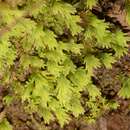Comprehensive Description
provided by Smithsonian Contributions to Botany
Fissidens asplenioides
Fissidens asplenioides Hedw., Sp. Musc. 156, 1801. [Original material: Jamaica, coll. Swartz, 1783–1787.]
Fissidens pycnotylus Broth. in Skottsb., Nat. Hist. Juan Fernandez 2:418, 1924. [Original material: Villagra, Mas a Tierra, ca. 600 m, coll. C. & I. Skottsberg n. 30 (S!).]
Plants in dense mats with stems to 3 cm long. Leaves in 10 or more pairs, 2–3 mm long, to 0.5 mm wide, oblong-lingulate, obtuse or bluntly acute, tips strongly curled when dry; vaginant lamina to 2/3 length of leaf, rounded at tip and ending near the costa; dorsal lamina tapering or rounded at base, ending distinctly above base of leaf; costa ending 4 or more cells below apex, rather sinuous distally; margin crenulate or serrulate, margin of vaginant lamina with many short, oblique, projecting cells; lamina cells 8–10 μm in diameter, rounded, mamillose, inner basal cells larger, to 15 or 20 μm, more subquadrate or polygonal, cells of vaginant lamina smooth. Seta 4–5 mm long. Peristome teeth papillose above. Spores 14–16 μm in diameter.
MAS AFUERA: Q. Casas, H. & E. 571; Q. Mono, H. & E. 659 in part; Q. Mono, near mouth, ca. 440 m, H. & E. 740b.
MAS A TIERRA: Villagra, ca. 600 m, Sk. 30 (type of F. pycnotylus, S).
The species is widely distributed, known from southeastern United States, West Indies, Mexico, Central and South America, Africa, Indonesia, Tasmania, and New Zealand. The species has been reviewed by Crum and Anderson (1965), but two additional features of the vaginant laminae have been noted: the rounded, almost auriculate tips of the lesser lamina, and the tendency of the lesser laminae to be on different sides of the plant in the different rows of leaves. The type specimen of F. pycnotylus seems in no way distinct. Brotherus (1924) compared his species with F. maschalanthus, remarking that the costa was much thicker.
- bibliographic citation
- Robinson, Harold E. 1975. "The mosses of Juan Fernandez Islands." Smithsonian Contributions to Botany. 1-88. https://doi.org/10.5479/si.0081024X.27

